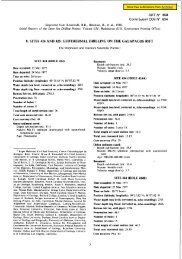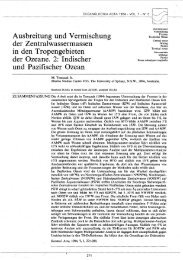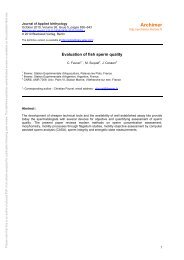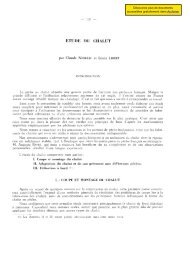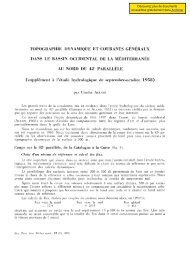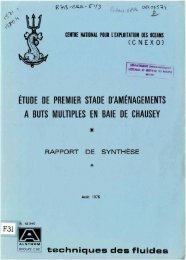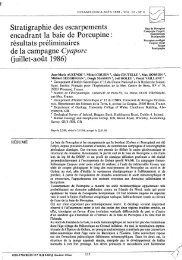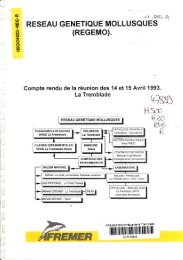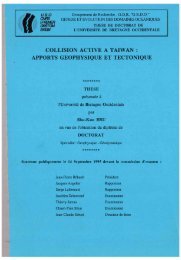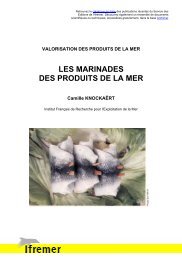Contribution à l'étude de virus de mollusques marins apparentés ...
Contribution à l'étude de virus de mollusques marins apparentés ...
Contribution à l'étude de virus de mollusques marins apparentés ...
You also want an ePaper? Increase the reach of your titles
YUMPU automatically turns print PDFs into web optimized ePapers that Google loves.
abnormal basophily of connective cells, presence of enlarged nuclei that show abnormal shape and<br />
chromatin pattern and con<strong>de</strong>nsed hyperbasophilic nuclei. These authors also report herpes<strong>virus</strong><br />
particles in association with these cellular alterations. Moreover, <strong>virus</strong> particles were olten observed in<br />
enlarged nuclei, but exceptionally in con<strong>de</strong>nsed nuclei (Renault et al., 1994b). For diagnostic purposes<br />
the nuclear alterations, particularly marginated chroma tin in hypertrophied nuclei, can be <strong>de</strong>tected by<br />
either light or transmisson electron microscopy. Although transmission electron microscopy is the most<br />
reliable method for the diagnosis of marine molluscs <strong>virus</strong>es actually, light microscopy allows to look to<br />
a greater number of animais in each sam pie (Table 1) and enhances <strong>de</strong>tection of animais suspected of<br />
carry ing the infection.<br />
The <strong>de</strong>monstration of herpes<strong>virus</strong> pathogenicity was performed by inoculating <strong>virus</strong> suspensions to<br />
axenic oyster larvae (Le Deuil et al., 1994). Sud<strong>de</strong>n and high mortalities occurred within Iwo to four<br />
days post-inocu lation. Viral particles were observed by transmission electron microscope analysis in<br />
moribund axenic oyster larvae, and histological and ultrastructural changes in these larvae were<br />
i<strong>de</strong>ntical to the les ions <strong>de</strong>scribed in naturally infected animais.<br />
ln the present study, mortalities of sets of oyster larvae from Marennes, La Trembla<strong>de</strong> and Arcachon,<br />
held at 25-26'C occurred sud<strong>de</strong>nly compared to the same sets held at 22-23'C. The mortalities of<br />
oyster larvae he Id at 25-26'C reached 100% on the 6th to the 13th day of culture, which was in<br />
accordance with previous reports of herpesviral infections (Hine et al., 1992; Nicolas et al., 1992), and<br />
with results concerning experimentally infected larvae (Le Deuil et al., 1994) which suggest that this<br />
<strong>virus</strong> may have a short multiplication cycle and a fast spread.<br />
Best survival rates were obtained for groups of larvae from Brest. Survival levels on the 15th day of<br />
culture was higher for larvae held at 25-26'C (44.4%) than for larvae held at 22-23'C (17.4%). These<br />
results cou Id be expected since high tempe ratures (25-26'C), in the absence of pathological problems,<br />
are optimal for the <strong>de</strong>velopment and survival of C. gigas larvae. In optimal conditions (25-26'C), a<br />
good survival rate of 40-50% is expected on the 15th day of culture, while it <strong>de</strong>creases to 10-20% at<br />
22-23'C for spawns obtained by go nad strip dissection method (A. Gérard, personal communication).<br />
Moreover, growth rates could not be related to the <strong>de</strong>velopment of herpes<strong>virus</strong> infection, since no<br />
noticeable dillerence could be observed belween groups of oyster larvae held .at the same<br />
temperature. But also, it could be expected that, at low temperature (22-23'C), larval growth is slower<br />
106



